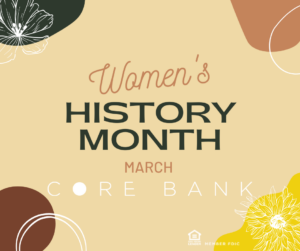
March is Women’s History Month and it’s significant to reflect on the many important contributions women have made to society, including in finance. Women’s contributions and accomplishments have largely been overlooked and consequently omitted from mainstream culture. This month’s observance had its origins as a national celebration in 1981 originally called “Women’s History Week.” Then in 1987, after Congress continued to pass resolutions, the President proclaimed March “Women’s History Month.” Many events over the past half-century have helped to expand the financial rights of U.S. women along with courageous women who persisted to make positive changes for their communities.
Up until the early 1970s, a woman’s application for credit could be denied if a husband did not co-sign, which often created obstacles for both married and single women. The Equal Credit Opportunity Act of 1974 changed this by prohibiting credit discrimination based on sex or marital status.
In 1975, First Women’s Bank was opened in New York City by women’s rights activist and writer Betty Friedan. This full-service bank catered to women customers, provided educational seminars for women, and helped foster equal opportunities for women in banking.
Rewinding back in history, it was Maggie Lena Walker who was the first woman to charter a bank. The St. Luke’s Penny Savings Bank was a community lending institution designed to promote savings and homeownership starting in 1903 serving the Richmond, VA area. Her bravery and trailblazing business spirit, at a time when women didn’t yet have the right to vote, is truly commendable.
Elouise Cobell (“Yellow Bird Woman”) fought tirelessly for Native Americans to have control over their own financial future after growing up hearing complaints about the Bureau of Indian Affairs (BIA). In 1987, she helped found the Blackfeet National Bank, now the Native American Bank, the first American bank owned by a tribe.
Muriel Siebert was known as The First Woman of Finance and also known as the first woman to become a member of the New York Stock Exchange in 1967 as well as the first woman to become the superintendent of banking for New York State in 1977.
Before Siebert, Abigail Adams was one of the earliest documented American women to invest. The wife of President John Adams is mostly noted for her documentation of the home front of the Revolutionary War and for her strident advocacy for women’s rights in the early years of the country’s founding. Abigail invested her “own pocket money” and was more interested in government bonds, securities sold by the government with the promise to repay the face value later as well as periodic interest payments in the meantime. With the return of her investments, she helped out other women in need, including her own sister.
An interesting invention that came about during the time of typewriters came from Bette Newsmith Graham. Graham was a single mother working as an executive secretary at Texas Bank & Trust when she saw a need for correcting typewriting errors on paper from the ink ribbon. She created a concoction in the early 1950s that worked as a correcting liquid for typewriting mistakes. This product became popular among the office, and she eventually sold her product called Liquid Paper.
Women have made numerous achievements over the course of American history in a variety of fields. Look for more commemoration of Women’s History Month throughout the month of March as we spotlight Women in Leadership at Core Bank.